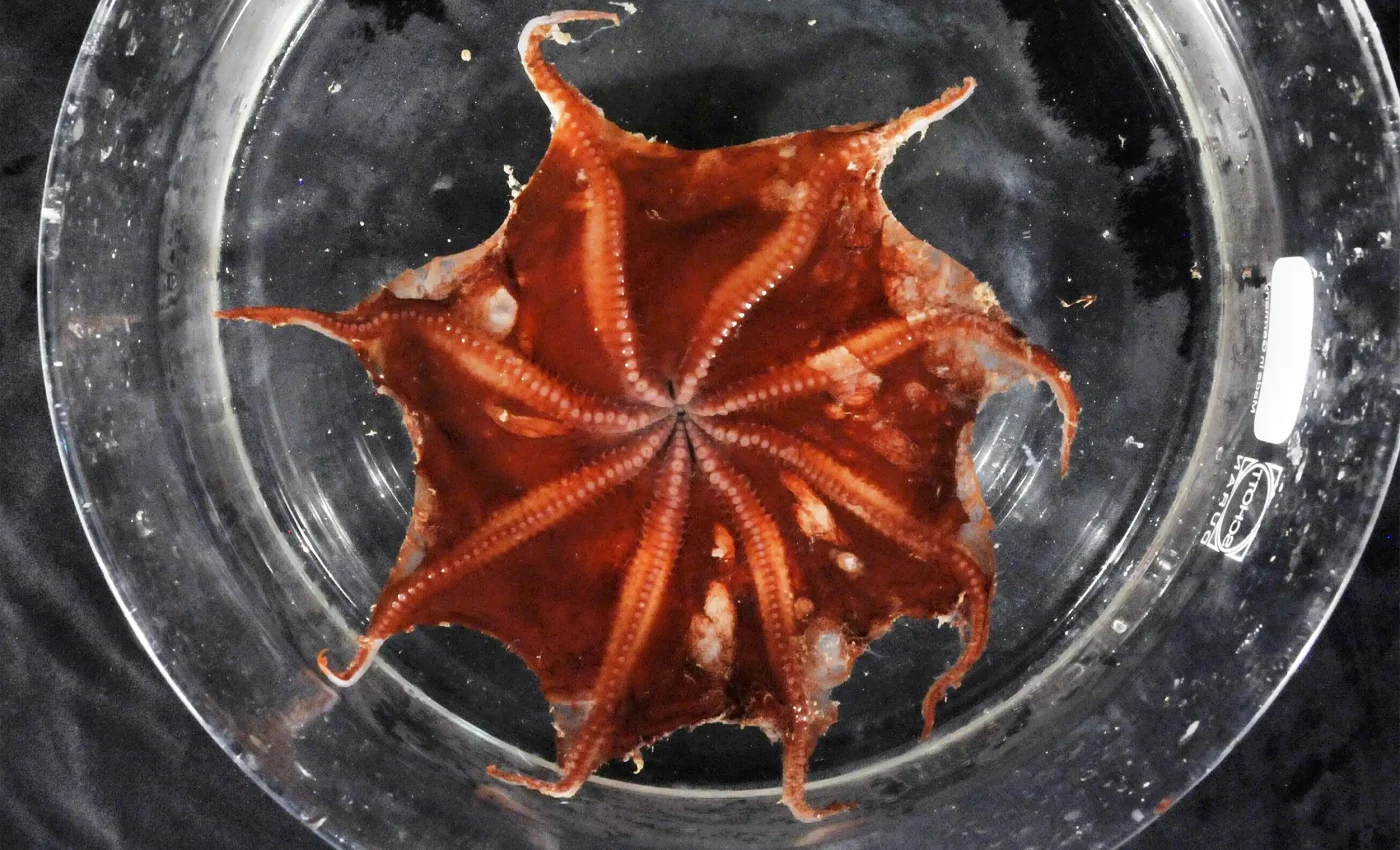
New octopus species discovered in very deep ocean waters
A new deep-sea octopus with a pancake-flat body and enormous eyes has been found off the coast of Australia. This tiny marine creature, now officially named Opisthoteuthis carnarvonensis – or the Carnarvon flapjack octopus – was discovered in the depths of the Carnarvon Canyon Marine Park.
It’s the latest of ten new species described from samples collected during a 2022 expedition aboard the RV Investigator.
The month-long voyage, led by Australia’s national science agency, was the first scientific survey of the seabed in both the Gascoyne and Carnarvon Canyon Marine Parks.
These parks, which are managed by Parks Australia, are located off Western Australia and had remained largely unexplored before the mission.
“Carnarvon flapjack” octopus
Scientists from the Tasmanian Museum and Art Gallery and the CSIRO’s Australian National Fish Collection worked with samples retrieved from depths between 1,044 and 1,510 meters (3,425 and 4,950 feet).
Using cameras, nets, and sleds, they surveyed remote parts of the seafloor. Among the findings was the Carnarvon flapjack octopus – a small, soft-bodied, gelatinous octopus about 4 centimeters (1.6 inches) in diameter.
“This new species is a flapjack octopus, which is a type of cirrate or ‘dumbo’ octopus found in the deep ocean. It is a small octopus, with a body length up to 40 mm, and has an orange-brown coloration,” said Dr. Tristan Verhoeff, a volunteer Systematic Taxonomist with the Tasmanian Museum and Art Gallery.
Carnarvon flapjack is unique
These dumbo octopuses are known for their distinctive look and fascinating behavior. With oversized eyes and the ability to flatten themselves like a pancake or curl up like a miniature umbrella, they are deep-sea shape shifters.
Their large eyes help them detect prey in the dim ocean depths, where they typically feed on worms and small crustaceans.
“Dumbo octopus are a rare and unusual species that live on the seafloor. They reproduce and grow slowly, are very soft and gelatinous and, unlike other octopus, they produce no ink and cannot change color,” Dr. Verhoeff added.
Although around 50 species of dumbo octopuses are known worldwide, 15 of them live in Australian waters. The new discovery highlights the rich but still poorly known biodiversity of Australia’s deep seas.
“Describing a new species is exciting but there is pressure to do it right and it takes time, as you have to look at comparative material and go through old literature,” Dr. Verhoeff continued.
“Many of the new species I have described have been in museums and other collections for decades awaiting someone to notice them.”
Why these discoveries matter
The discovery of the Carnarvon flapjack octopus adds even more importance to these protected marine parks.
“Describing new species is also essential for future work on their ecology, and assessing populations for conservation,” explained Dr. Verhoeff.
Dr. Lisa Kirkendale from the Western Australian Museum emphasized how much more there is to learn.
“Discovering new species of macroscopic marine animals illustrates how little we still know about the deep sea in this area,” Dr. Kirkendale noted.

“The Indian Ocean is truly a frontier for marine biodiversity research and the WA Museum is the region’s institutional hub as we move forward to address this challenge.”
She also commented on the importance of supporting experts in taxonomy.
“In Australia, we need to better support taxonomists, like Tristan, to continue to document fabulous new species, such as the Carnarvon flapjack octopus,” she added.
New species in the unknown depths
“The 2022 voyage off Western Australia has been vital for increasing our understanding of the seafloor habitats and biodiversity in the region,” said Dr. Venetia Joscelyne, Team Leader at CSIRO Marine National Facility.
Dr. Joscelyne also highlighted the scope of the mission’s outcomes, saying, “From this single research voyage alone, we are seeing many new marine species being described.”
Incredibly, scientists estimate that there are likely more than 1,000 new species waiting to be described from specimens collected on RV Investigator voyages over the past 10 years.
RV ocean research is vital
Conducting research in remote, offshore, or deep ocean environments is challenging but that remotely operated vehicles, like the RV Investigator, are able to provide researchers with an impressive range of capabilities to glimpse into the unknown deep.
“These discoveries are vital in helping us understand the conservation needs of the marine parks and will assist Parks Australia in maintaining the marine parks’ natural values in the future,” said Joscelyne.
From an orange-brown octopus to colorful scorpionfish and hornsharks, Australia’s unexplored ocean canyons are proving to be treasure troves of biodiversity.
The little Carnarvon flapjack octopus may be small, but it plays a big role in reminding us how much of the deep ocean remains a mystery that is waiting to be studied, understood, and protected.
The full study was published in the journal Australian Journal of Taxonomy.
—–
Like what you read? Subscribe to our newsletter for engaging articles, exclusive content, and the latest updates.
Check us out on EarthSnap, a free app brought to you by Eric Ralls and Earth.com.
—–













